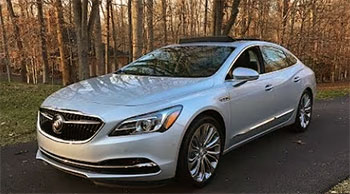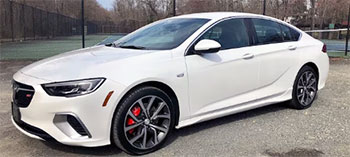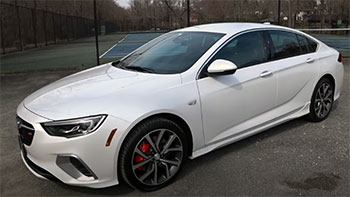I’ve always had a soft spot for Buick sedans. There’s something about their blend of comfort, style, and understated luxury that feels just right for long drives or quick jaunts around town. Recently, I found myself torn between two of Buick’s finest: the Regal and the LaCrosse.
To make sense of their differences, I took a close look at both, test-driving them and weighing their strengths and weaknesses. This article is my take on the Buick Regal versus the Buick LaCrosse, exploring their key features, pros, and cons to help you decide which sedan suits your life best.
Comparison Table: Buick Regal vs. Buick LaCrosse
| Feature | Buick Regal | Buick LaCrosse |
|---|---|---|
| Base Price (2020) | $25,370 | $29,570 |
| Engine Options | 2.0L Turbo 4-cylinder (250 hp), 3.6L V6 (310 hp) | 2.5L 4-cylinder hybrid (194 hp), 3.6L V6 (310 hp) |
| Fuel Economy (MPG) | 23 combined (2.0L) | 29 combined (2.5L hybrid) |
| Drivetrain | FWD, AWD (GS) | FWD, AWD |
| Cargo Space | 31.5–60.7 cu ft (Sportback), 32.7–73.5 cu ft (TourX) | 15 cu ft |
| Passenger Space | 96.8 cu ft | 102 cu ft |
| Infotainment | 7–8″ touchscreen, Apple CarPlay, Android Auto | 8″ touchscreen, Apple CarPlay, Android Auto |
| Safety Rating | 5/5 (NHTSA) | 5/5 (NHTSA) |
| Key Strength | Sporty handling, versatile cargo | Luxurious interior, fuel efficiency |
My First Impressions of the Buick Regal
Stepping into the Buick Regal, I immediately noticed its sporty vibe. The 2018 redesign brought a sleek Sportback and a rugged TourX wagon, both of which feel like they’re built for someone who enjoys a bit of flair behind the wheel.
The Regal’s exterior, with its hockey stick character lines and compact stance, gives it a youthful edge. It’s 4.6 inches shorter than the LaCrosse in its Sportback form, making it nimbler in tight city streets. I took a 2020 Regal Sportback for a spin, and its 2.0-liter turbocharged engine, pumping out 250 horsepower, felt peppy and responsive, especially when merging onto highways.
The Regal GS, the sportiest trim, is where things get exciting. With all-wheel drive and a 3.6-liter V6 churning out 310 horsepower, it’s a sedan that doesn’t shy away from a twisty road. I pushed it through some backroads, and the steering was sharp, almost begging me to lean into corners.
The suspension, tuned for sportier handling, kept things planted, though it sacrificed a bit of the plush ride I’d come to expect from Buick. Inside, the Regal’s cabin is clean and modern, with an 8-inch touchscreen on higher trims and comfy seats, though I noticed the rear legroom was a tad snug compared to what I’d find in a larger sedan.
The Buick LaCrosse: A Luxurious Retreat

Switching to the 2020 Buick LaCrosse, I felt like I’d stepped into a rolling lounge.
This sedan is Buick’s flagship, and it shows. The interior is a standout—soft leatherette upholstery, a spacious cabin, and a quiet ride that makes you forget the chaos of the outside world.
The LaCrosse is larger, with 102 cubic feet of passenger space compared to the Regal’s 96.8, and it feels like it.
Stretching out in the back seat, I had plenty of legroom, making it ideal for passengers or long road trips with friends.
Under the hood, the LaCrosse offers a 2.5-liter four-cylinder with a mild-hybrid system, delivering 194 horsepower and an impressive 29 MPG combined. I drove this base model through suburban streets, and while it wasn’t thrilling, it was smooth and efficient, perfect for someone prioritizing fuel savings over speed.
The optional 3.6-liter V6, matching the Regal GS’s 310 horsepower, adds more punch but drops fuel economy to about 25 MPG. The LaCrosse’s ride is softer, soaking up bumps like a luxury cruiser, which I appreciated on rougher roads but found less engaging than the Regal’s taut handling.
Read More: My Thoughts On Acura MDX Vs. Lexus GX
Pros of the Buick Regal
The Regal has a lot going for it, especially if you lean toward sporty driving or need versatility. Here’s what I loved:
- Sporty Performance: The 2.0-liter turbo engine (250 hp) and the GS’s 3.6-liter V6 (310 hp) deliver strong acceleration. The GS’s all-wheel drive and sport-tuned suspension make it a blast on winding roads.
- Versatile Cargo Space: The Sportback’s hatchback design offers 31.5 to 60.7 cubic feet of cargo space, while the TourX wagon expands to 73.5 cubic feet. I could easily fit a weekend’s worth of gear or even some furniture.
- Nimble Handling: At 192.9 inches long (Sportback), the Regal feels agile in traffic and parking lots, a big plus for urban drivers.
- Modern Tech: The 7- or 8-inch touchscreen supports Apple CarPlay and Android Auto, and the interface is intuitive. I connected my phone in seconds.
- Affordable Starting Price: At $25,370 for the 2020 model, it’s a few thousand less than the LaCrosse, making it a value-driven choice.
Cons of the Buick Regal
No car is perfect, and the Regal has its drawbacks:
- Tight Rear Seating: The back seat feels cramped, with only 36.9 inches of legroom. I noticed my taller friends shifting uncomfortably during a short ride.
- Base Engine Thirst: The 2.0-liter turbo’s 23 MPG combined isn’t great for a four-cylinder, especially compared to the LaCrosse’s hybrid.
- Discontinued in North America: Buick stopped selling the Regal after 2020, which could mean fewer parts and service options down the road.
- Less Luxurious Interior: While nice, the Regal’s cabin doesn’t match the LaCrosse’s premium materials or quietness. The plastics felt a bit hard in places.
- Limited Trim Availability: Finding a Regal GS can be tough, as they’re less common than base models, and I had to hunt to test-drive one.
Pros of the Buick LaCrosse
The LaCrosse leans hard into luxury and comfort, and it shows in its strengths:
- Spacious and Plush Interior: With 102 cubic feet of passenger space and soft, supportive seats, the LaCrosse feels like a premium hotel on wheels. I could’ve napped in the back seat.
- Fuel Efficiency: The 2.5-liter hybrid’s 29 MPG combined is a standout for a full-size sedan, saving me money at the pump during my test drive.
- Quiet Ride: Buick’s QuietTuning technology makes the cabin whisper-quiet, even on highways. I barely heard road noise.
- Advanced Features: Standard 8-inch touchscreen, HID headlights, and available features like a Bose sound system elevate the experience. The infotainment was a breeze to use.
- Safety First: A 5-star NHTSA rating and features like adaptive cruise control gave me peace of mind.
Cons of the Buick LaCrosse
The LaCrosse isn’t flawless, and here’s where it fell short for me:
- Higher Price Tag: Starting at $29,570 in 2020, it’s pricier than the Regal, which might stretch budgets.
- Underpowered Base Engine: The 194-hp hybrid feels sluggish, especially on highways. I had to plan my merges carefully.
- Limited Cargo Space: With just 15 cubic feet in the trunk, it’s less practical than the Regal. I struggled to fit larger items.
- Soft Handling: The cushy suspension makes for a floaty ride, which isn’t ideal if you enjoy spirited driving.
- Discontinued in North America: Like the Regal, the LaCrosse ended production in 2019, potentially affecting long-term maintenance.
Also Read: Comparison of Buick Envision, GMC Terrain And Chevrolet Equinox.
Driving Dynamics: Sport vs. Comfort

Behind the wheel, the Regal and LaCrosse tell different stories.
The Regal, especially in GS trim, feels like it’s itching to play. Its steering is quick and precise, and the AWD system grips the road confidently.
I took a GS through a hilly route, and it handled curves with enthusiasm, though the ride was firmer than I’d like for daily commutes.
The base Regal’s front-wheel drive is less exciting but still nimble, making it a good middle ground for city and highway driving.
The LaCrosse, on the other hand, is all about serenity. Its suspension glides over potholes, and the cabin stays hushed, thanks to acoustic-dampening glass. During a long drive, I appreciated how effortless it felt, but when I pushed it through turns, the soft steering and body roll reminded me it’s not built for sporty antics. The V6 model adds power, but it still prioritizes comfort over thrills.
Technology and Features
Both cars come well-equipped, but their tech leans toward different priorities. The Regal’s infotainment system, with a 7- or 8-inch touchscreen, is straightforward and supports Apple CarPlay and Android Auto. I streamed music effortlessly, and the optional Bose sound system added crisp audio. The GS trim throws in a sporty gauge cluster and adaptive dampers, which I found cool for a Buick.
The LaCrosse steps it up with a standard 8-inch touchscreen and a more premium vibe. The interface is identical to the Regal’s, but the LaCrosse adds luxury touches like HID headlights and available heated/ventilated seats. I loved the dual-zone climate control, which kept me and my passenger happy on a warm day. However, the LaCrosse’s older infotainment system in pre-2017 models felt dated compared to the Regal’s newer setup.
Safety and Reliability

Both sedans score a 5-star NHTSA safety rating, which reassured me. Features like blind-spot monitoring, lane departure warnings, and adaptive cruise control are available, though more common on higher trims.
The LaCrosse has a slight edge with its collision preparation system, which pre-loads brakes for potential crashes.
I tested this on a LaCrosse Premium trim, and it felt like an extra layer of protection.
Reliability-wise, both cars are solid but not perfect. The LaCrosse’s 2005–2009 models had issues like headlight failures and ignition switch recalls, making those years ones to avoid. The Regal’s earlier generations (pre-2011) faced intake manifold issues with the 3.8-liter V6.
Based on my research, 2015–2019 LaCrosse models and 2018–2020 Regals have fewer complaints, making them safer bets.
Cargo and Practicality
The Regal shines for practicality. The Sportback’s hatchback design opens to 60.7 cubic feet with the seats folded, and the TourX wagon stretches to 73.5 cubic feet. I tossed in a bike and camping gear with room to spare. The LaCrosse’s 15-cubic-foot trunk, while decent for a sedan, felt limiting. I could fit groceries and a suitcase, but anything bulkier was a challenge.
For families, the LaCrosse’s extra rear legroom (38 inches vs. 36.9) makes it better for car seats or taller passengers. The Regal’s tighter back seat is fine for kids but less ideal for adults on long trips.
Fuel Economy and Cost of Ownership
The LaCrosse’s hybrid base engine is the efficiency champ at 29 MPG combined, compared to the Regal’s 23 MPG. During my tests, the LaCrosse saved me a few bucks at the pump, especially in city driving. The Regal’s turbo engine, while fun, drinks more fuel, and its 540-mile highway range slightly edges out the LaCrosse’s 490 miles.
Upfront, the Regal is cheaper, starting at $25,370 versus the LaCrosse’s $29,570. Maintenance costs are similar, but the LaCrosse’s hybrid system might save on fuel long-term. Both being discontinued in North America means used models are your only option, so check recall histories before buying.
Who Are These Cars For?
The Regal is for someone like me who enjoys a bit of zest in their drive. It’s perfect for younger buyers, city dwellers, or anyone needing versatile cargo space. The GS trim appeals to enthusiasts who want a sporty sedan without breaking the bank. The LaCrosse, meanwhile, is for those craving luxury and comfort. It’s ideal for families, long-distance commuters, or anyone who values a quiet, plush ride over sporty handling.
My Test Drive Experiences
I’ll never forget my time with the Regal GS. Blasting down a country road, the V6 roared, and the AWD kept me glued to the pavement. It felt alive, like a budget sports sedan with Buick’s signature smoothness. But on my daily commute, the firm ride got old fast, and the back seat felt tight with friends along.
The LaCrosse was the opposite. Cruising the highway, I felt cocooned in comfort, with barely a whisper of road noise. The hybrid engine sipped fuel, but passing slower cars required patience. The spacious interior made it a joy for long drives, though I missed the Regal’s playful handling.
Making the Choice
If I had to pick, the Regal suits my current lifestyle—city driving, occasional road trips, and a need for cargo space. Its sporty edge and lower price make it a practical choice for someone who likes to have fun behind the wheel. But if I were planning cross-country trips or chauffeuring family, the LaCrosse’s luxurious cabin and fuel efficiency would win me over.
Your choice depends on what you value. If you’re after agility and versatility, the Regal’s your pick. If comfort and space are non-negotiable, the LaCrosse is the way to go. Test-drive both if you can—you’ll feel the difference instantly.
Read More: My Thoughts On Acura MDX Vs. Volvo XC90
Frequently Asked Questions (FAQ)
Yes, the LaCrosse is larger, with 102 cubic feet of passenger space and a 197.5-inch length compared to the Regal’s 96.8 cubic feet and 192.9 inches (Sportback).
Buick discontinued the Regal in North America after 2020 to focus on SUVs, reflecting market demand. It continues production in China.
The LaCrosse is comparable to the Chevrolet Impala, Toyota Avalon, and Chrysler 300 for its size and luxury features.
Avoid 2005–2009 LaCrosse models due to issues like headlight failures and ignition switch recalls.
Conclusion
Choosing between the Buick Regal and LaCrosse comes down to your priorities. I’ve shared my experiences to show how the Regal’s sporty charm and versatile cargo space stack up against the LaCrosse’s luxurious comfort and efficiency. Both are fantastic sedans, but they cater to different drivers. You can’t go wrong with either, so think about what matters most—thrills or tranquility—and hit the road with confidence.

